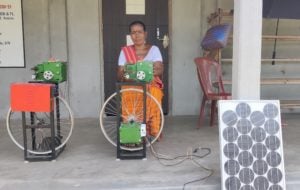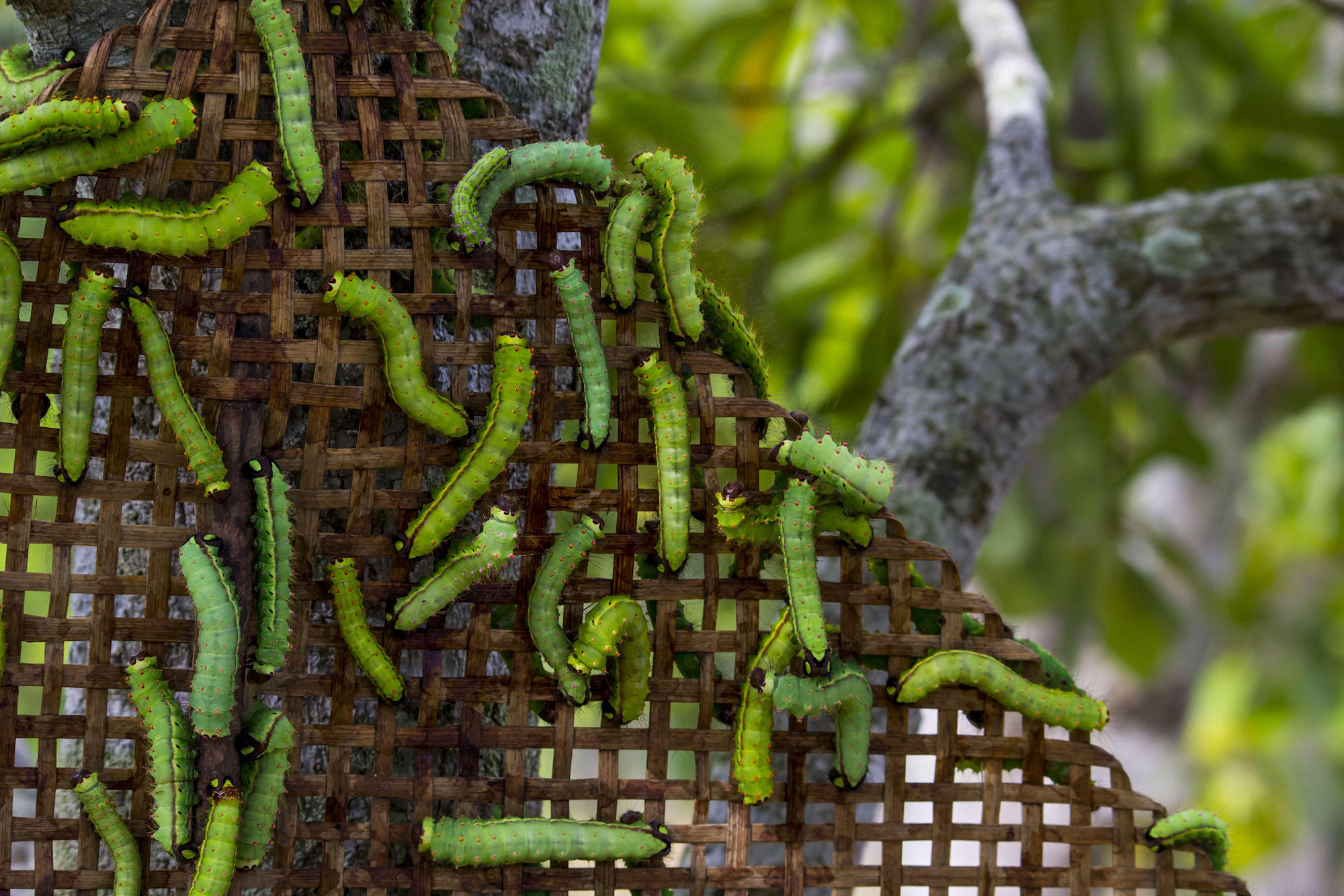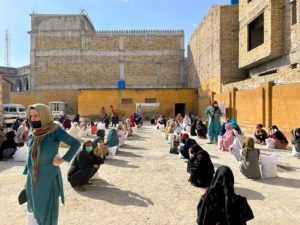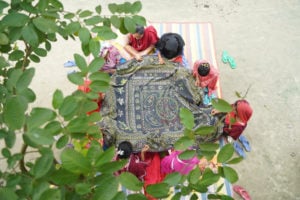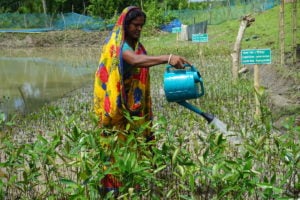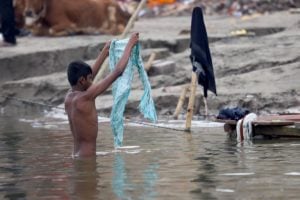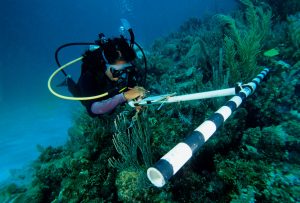Budhari Goyari is busy spinning cocoons of ‘eri’ silk in the courtyard of her two-room house in Bhaoragwaja village, in the Kokrajhar district of Assam, north-eastern India. Beside her container of silk cocoons, Goyari sits with a solar-powered spinning machine.
Goyari, a member of the Bodo tribe, a minority indigenous community, is one of 20,000 women in tribal and rural areas of India who own solar-powered spinning machines manufactured by Resham Sutra, a Delhi-based social enterprise.
Before she made the switch to the solar-powered machine in 2019, Goyari would reel cocoons using the traditional manual technique of thigh-reeling, which was laborious and painful. “I would sit cross-legged to reel silk cocoons, and twist these filaments with my hands,” Goyari explains. The process caused her to develop rashes and wounds on her thighs – a common injury with this technique. “I would [also] experience pain in my back, neck, and legs daily, as I had to sit in one position for five to six hours a day.” And, as electricity supply is frequently disrupted in her village, she would often have to work in dim light, straining her eyes.
“Despite that much hard work, I would produce only 100 grams of silk and earn hardly INR 100 [USD 1.21] per day,” she says. But since she has started to reel silk cocoons using the solar-powered machine, she says her production and income have doubled. Goyari now reels almost 250 grams of silk per day and earns INR 250 by selling that silk yarn to traders – more than double what she used to produce and earn. She also no longer experiences injuries or pain.
Addressing issues in the silk industry
Kunal Vaid, Resham Sutra’s founder and director, says the solar-powered spinning machine initiative was inspired by several factors. A veteran of the textile industry, he saw how silk spinners and reelers suffered injuries from the spinning process on work visits to Jharkhand and other states in north-east India. Through talking with spinners, he discovered that the younger generation was generally not interested in continuing the traditional work of thigh-reeling. He says these realisations spurred him and his team to innovate with machines that would lessen the physical toll that silk spinning had on artisans and make it a lucrative and feasible source of employment.
Since Goyari started to use the solar-powered spinning machine, she has had an uninterrupted supply of solar power for her loom. The social enterprise Resham Sutra provides back-up solar batteries so she can work at night and during the rainy season, when it’s too cloudy for the solar panels to be used as a direct energy source, as well as one lightbulb for her to work on spinning at any time of the day.
Since its inception in 2019, the initiative has reached 350 villages across 16 states, Vaid says, through both direct purchase and government distribution. But the rollout has not been without its challenges, such as silk spinners’ general reluctance to adopt an entirely new method of spinning.
“It’s difficult to mobilise women from rural areas and convince them to use machines,” he says. Though more affordable than diesel-powered looms, Resham Sutra’s machines still come up to INR 10,000-40,000 (USD 120-480), around 100 times Goyari’s previous daily income.
To quell concerns about this investment, the enterprise conducted awareness sessions with local social workers who shared the benefits of the machines – and of solar power – to the silk spinners. Artisans were generally concerned about how to use the machines, how long they are productive, how easy they are to operate and whether the silk generated is of high quality. The social enterprise reports relative success: they have sold 20,000 solar-powered spinning machines over four years.
Owing to the cost of Resham Sutra’s looms, the enterprise has been linking interested silk spinners with banks and other lenders, such as non-banking financial companies, for financial assistance in purchasing the machines.
Empowering women, the backbone of the silk industry
Silk is one of India’s most significant exports: the country is the second-largest raw silk producer in the world, with a nearly 18% share of global production – just behind China. Sericulture, or silk farming, is one of the largest sources of employment in rural areas of India, and women comprise 60% of the silk workforce, according to the Government of Assam’s Directorate of Sericulture.
Making the move from thigh-reeling to machine-spinning gives women potential to earn more, as machine-spun silk yarn typically has higher uniformity and can command better prices for woven silk.
Kunni Dehury, a 35-year-old tribal woman from Keonjhar, in Odisha state on the east coast of India, says rates for her silk yarn have increased since she began using a solar-powered machine. “I used to produce 50 grams of yarn and would earn INR 100 [USD 1.20] per day,” she says. With the machine, she produces five times the amount of silk in the same amount of time. “Now traders offer me INR 8,000 [USD 96] per kilogram for silk I produce with the machine.”
Towards a carbon-neutral silk industry
Many of the Indian silk industry’s six million workers are small or marginal farmers who reel and spin silk (marginal farmers are those who cultivate land of up to one hectare). Those who do not use the thigh-reeling technique typically use diesel or electricity-powered spinning machines.
Many “tribal or rural artisans use power looms or diesel-powered machines to reel silk, causing air and noise pollution,” says Abhishek Jain, director of the Powering Livelihood Programme, a joint initiative between policy research NGO the Council of Energy, Environment and Water (CEEW), and the NGO Villgro. The Powering Livelihood Programme partnered with Resham Sutra to publicise this initiative to potential customers. He adds that while some artisans also used electricity-powered looms, “solar power [and related machinery] is rarely available in rural India.”
Data on the carbon emissions of diesel- and electricity-powered spinning machines is limited, but the carbon footprint of all silk clothing in the United Kingdom in 2009, from production to end of life, was calculated at around 25.4 tonnes per tonne of silk, according to research by environmental NGO the Waste & Resources Action Programme. According to Vaid, each of Resham Sutra’s solar-powered machines is estimated to prevent about 850 kilograms of CO2 emissions per year, and the 20,000 machines machines sold may have prevented the emission of 17,000 tonnes of CO2 per year.
To take this programme wider, we need policy support at various levelsKunal Vaid, founder and director, Resham Sutra
Additionally, electricity supply is unreliable in many villages in India’s north-eastern and eastern states – an important silk-producing region, and the traditional centre for production of silks such as Eri, Muga and Tussar. Spinners who use standard electricity-powered machines are entirely at the mercy of an irregular power source that dictates how productive they can be on that day, and how much their income will be.
Beyond the spinning machines, the Resham Sutra initiative is hoping to bring the silk industry one step closer to carbon neutrality via its use of solar power throughout the supply chain. Silk yarns are sold to artisans with solar-powered looms, and “when weavers produce fabric, they are further connected with manufacturers who use solar-based sewing machines, so the whole supply chain in this trade is powered with solar-based equipment,” explains Sreejith Narayanan, program coordinator at Villgro, an NGO that is collaborating with Resham Sutra on the initiative.
Kunal says that Resham Sutra is aiming to expand the initiative across India. “But to take this programme wider, we need policy support at various levels,” he says, such as provision of low-cost loans for artisans to purchase the machines and greater awareness among rural producers.
The social enterprise is also keen to see special industry certification for products developed using solar-powered machines as green and sustainable to make them more attractive to buyers, as well as a wider digital ecosystem for producers to sell their products beyond the programme’s internal marketplace.
Speaking about the solar-powered looms initiative, Kiran Malali, a scientist at the Central Silk Board, under India’s Ministry of Textiles, tells The Third Pole: “Tribal and rural women used to produce silk using manual drudgery ways. But due to this technological intervention, women with new skills produced better quality and quantity silk.”
Editor’s note: This article was amended on 22 September to replace references to ‘weaving machines’ and ‘weavers’ with the correct references to spinning machines and spinners.
